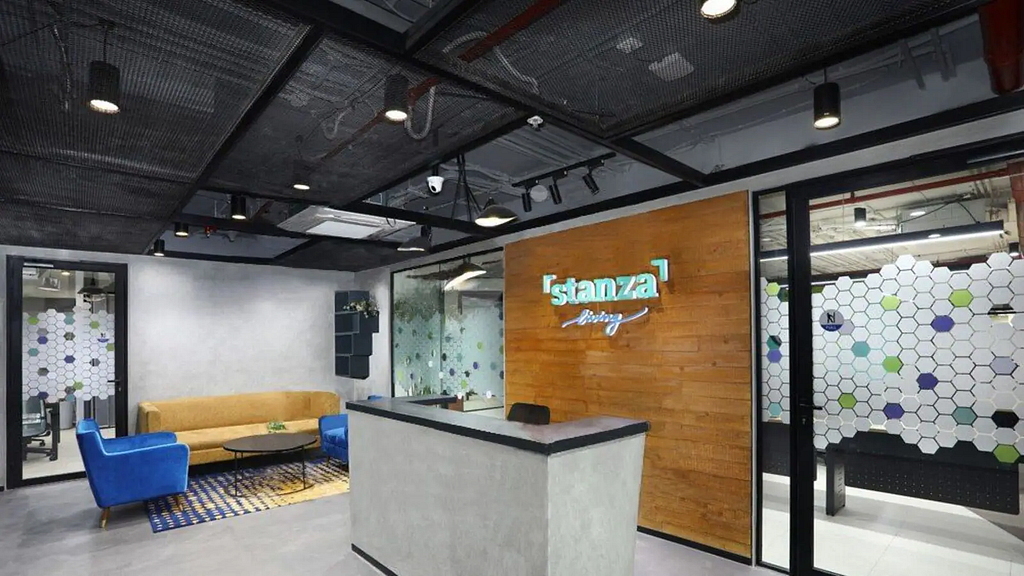
The Dawn of the New Dorms
In Frame: Stanza Living
In recent years, India has witnessed a burgeoning demand for quality higher education, leading to an unprecedented growth in its student population. This surge has brought to light a critical aspect of the educational ecosystem: student housing.
As universities and colleges strive to accommodate the increasing number of students, traditional hostel setups are rapidly becoming outdated. Enter the new wave of student housing — modern, well-equipped, and designed to meet the diverse needs of today’s learners.
India’s Student Population Has Been Expanding With a Growing Need for Quality Education
There are approximately 500 million people who fall under the education-seeking population. India’s economic growth and rising incomes have enabled more families to afford higher education. Rapid urbanization and improved infrastructure have increased accessibility, encouraging students from rural areas to pursue education in cities.
Government initiatives, such as expanding public universities and inclusive education policies, further support this growth. Additionally, increased awareness of education’s value in achieving better career prospects is driving higher enrolment rates.
Such expansion in student population and growth in India’s higher education institutions has been reflected in the rising Gross Enrolment Ratio across institutions in the country. This not only fuels the demand for academic resources but also amplifies the necessity for comprehensive support systems, including modern and well-equipped student housing solutions.
This Has Led to the Mushrooming Growth of Higher Education Colleges and Universities in India
In response to the escalating demand for quality education, numerous new institutions have been established, while existing ones have expanded their capacities and upgraded their facilities.
This rapid proliferation of educational institutions is evident across metropolitan cities as well as smaller towns. As these colleges and universities strive to attract and accommodate the growing number of students, they face the dual challenge of maintaining high academic standards and providing adequate infrastructure, including modern student housing.
While Such Secular Growth Trends Persist Across India HigherEd, Student Housing Continues to Face Many Challenges
Traditional student housing solutions face numerous obstacles that hinder their ability to meet this growing demand effectively, including outdated facilities lacking essential amenities like high-speed internet, proper study spaces, and sanitation. Poor management practices result in inefficient maintenance and substandard living conditions. Overcrowding due to capacity constraints forces many students to rely on overpriced private accommodations with inadequate facilities.
Limited quality alternatives near HEIs exacerbate the issue, and high costs in private HEIs make affordable housing scarce, especially in metropolitan areas. On top of that certain problems are endemic to India. For example, most property owners avoid students, young working professionals, or unmarried couples.
Universities in India Have Exhausted Their Existing Student Housing Capacity With No New Capacity Planned
None of the public universities have enough hostels for their students. Most private universities also suffer from the same problem. Most Indian universities are facing a critical shortfall in student housing capacity, having fully utilized their existing accommodations without any substantial plans for expansion.
Small private unorganized players have traditionally met this scarcity in student housing. With the growing emphasis on higher education as a pathway to better career prospects, more students are flocking to universities, exacerbating the demand for on-campus housing.
A recent Colliers India study found that student relocation within India is expected to touch 31.1 million by 2035–36, from around 11.3 million as of 2021–22. The student relocation for higher education is expected to grow at a CAGR of 7.5% per annum, opening a vast market potential.
Such a Demand-Supply Gap Has Given Rise to New Business Models in Indian Student Housing
In Frame: Good Host Spaces Student Hostel at O.P. Jindal University
The growing disparity between the demand for student accommodation and the limited supply has spurred the development of innovative business models in the Indian student housing sector. These new models are designed to address the shortcomings of traditional housing options by providing enhanced living experiences, better management, and modern amenities.
The novel business models in the Indian student housing sector can be categorized into two broader groups:
1. Purpose-Built Student Accommodation (PBSA): PBSA are custom-built facilities specifically designed to house students. These accommodations are developed and managed by private companies and are often located off-campus but close to educational institutions. Unlike traditional hostels, PBSA focuses on professional management with high standards of security and maintenance, while providing a wide range of amenities with a focus on a holistic living experience for students.
The Purpose Built Student Accommodation (PBSA) Market has seen immense growth in recent years, with the rise of many student housing brands in the sector. Currently, many private developers and investors are planning an expansion into student housing facilities in India. Few of the prominent Student housing operators are mentioned below:Good Host Spaces is India’s largest on-campus student housing platform with ~50k beds in its portfolio across 5 locations in India. Existing portfolio of GHS includes OP Jindal Global University, Manipal University, Shoolini University, TAPMI Manipal, with upcoming projects in Punjab, Maharashtra and Gujarat.Hosur Coliving, established in 2018, currently has a presence in Bengaluru, Delhi NCR, Pune, and Hyderabad cities with a total stock of 3,250 beds, and it has planned to add 7000 beds by 2023–24.Stanza Living currently has 70,000 beds pan India and is targeting to expand to 30,000 beds by 2023 year-end.
Your Space is one of the leading student housing operators. It has a presence in Delhi, Mumbai, and Pune with a total of 5,500 beds, and it has plans to reach a total of 20,000 beds by 2023–24.
2. Student Housing Marketplaces or Aggregators: Marketplace models are becoming commonplace driven by the unorganized nature of the student housing industry. Online platforms aggregate various student housing options, allowing students to search, compare, and book accommodations. They bring transparency and convenience to students by providing detailed information regarding a wide range of housing options on a single platform.
The growth in student housing marketplaces has been riding on the digitalization trend across the Indian economy. With increasing digital penetration in India, leading marketplaces are seeing solid traction and many students are actively leveraging them to find well-suited accommodation for themselves.Leading players amongst the student housing marketplaces include University Living, Uniacco, RoomPe, Casita and Homeversity.
The Emergence of Such New Business Models is Yielding Multiple Benefits to Colleges and Universities
In Frame: PBSA in India
New business models of student housing differ significantly from traditional models by prioritizing modern amenities, convenience, and comprehensive support services. Unlike traditional dormitories often managed directly by universities, these new models typically involve private-sector partnerships or standalone developments that offer state-of-the-art facilities.
This shift enhances the student living experience and fosters community through common areas and social events. Such options also provide financial predictability to students with all-inclusive rent packages. Apart from the benefits to students, such models are value accretive to higher education institutions in multiple ways:
Enhanced Attraction and Retention: Colleges with access to quality PBSA facilities can attract a higher number of students by offering high-quality living conditions, and contributing to overall student satisfaction and retention rates, positively impacting the institution’s reputation.Resource Optimization: Partnering with PBSA providers can alleviate the financial and administrative burden of managing on-campus housing, allowing colleges to focus resources on academic and extracurricular offerings, and reducing focus on hostel-oriented capex optimization and utilization.Alleviating Operational Burden: Managing student housing can be a significant operational burden for educational institutions. By partnering with a specialized PBSA provider, colleges and universities can transfer the operational responsibilities of managing student accommodations, including maintenance, security, and student services.Enhanced Student Support: Quality accommodation supports the holistic development of students, contributing to their academic success and well-being. PBSA facilities can serve as hubs for student engagement and community activities, enhancing the campus life experience.
The Indian Student Housing Market is Poised for Transformative Growth Driven by a Confluence of Powerful Factors
In Frame: Stanza Living Frankfurt House
The Indian student housing market stands on the brink of transformative growth, fueled by a dynamic interplay of demographic, economic, and social factors. As the demand for higher education continues to surge, the need for quality student accommodation is becoming more critical than ever. Multiple growth drivers are fueling the rise of the student housing market in India:
Growing Student Population: According to the report published by the All India Survey on Higher Education, more than 40 million students are currently enrolled in 1,168 universities and 45 thousand-plus colleges and stand-alone institutes in India. These numbers are constantly growing with the growth in the student population in India.Student Relocation: As per Colliers, student relocation for higher education is expected to grow at a CAGR of 7.5% p.a. from 11.3 Mn (2021–22) to 31.1 Mn in 2035–36P. This will result in a rise in total student enrolment from 42.3 Mn in 2021–22 to 92.0 Mn by 2035–36.Increasing Gross Enrolment Ratio (GER): As per NEP 2020 targets, student enrollment in higher education is expected to reach 92.0 Mn with 50.0% GER by 2035–36P, driven by the provision of quality infrastructure and various initiatives under NEP such as the introduction of multidisciplinary curriculum, integrating vocational training, multiple entry and exits during a course, etc.Lack of Structured PBSA Offering: Current market offerings primarily comprise residential buildings with rental units, paying guest (PG), and aggregator operators, who have limited focus on ESG aspects and lack safety and hygiene. Most properties are typically poorly maintained and lack services from professional and management staff.Attractive Opportunities for Investors: Student housing in India offers an attractive alternative asset class for investors providing stable and resilient cash flows while having immense untapped potential in an unorganized market.Students’ preference for quality organized accommodation: Students are increasingly seeking organized accommodation that offers a holistic living experience. This demand for high-quality, well-managed housing is pushing developers to innovate and raise the standards of student living environments, further driving the sector’s growth.Supply-Demand Gap in Student Housing: There are limited student hostel beds available as compared to total student enrolment in higher education. As per Colliers, there are only 7.5 Mn beds available, whereas, the total student relocation is 11.3 Mn as of 2021–22. There is a demand-supply gap of 3.5 Mn beds in the market, translating to a demand of 2 students per bed.
Such structural growth drivers are acting as enablers for the nascent organized student housing industry in India. Together, these factors are setting the stage for a transformative phase in India’s student housing market, leading to increased investability in the sector.
These Growth Drivers In Confluence With Sectoral Nuances are Driving Investment Considerations in the Asset Class
In Frame: Good Host Spaces Student Hostel at Manipal University
As India’s higher education landscape expands, fueled by demographic trends, rising enrollment, and urban migration, the demand for quality student accommodation is skyrocketing. Simultaneously, the sector’s inherent nuances, such as stable occupancy rates, resilient demand, and the shift towards organized living spaces, are providing compelling reasons for investors to consider student housing as a viable and profitable investment opportunity. A host of investment considerations are driving capital towards the sector:
Steady income and solid income growth: Investments in student housing offer steady income streams, bolstered by predictable rental payments and high occupancy rates. With a consistent influx of students each academic year, investors can expect reliable revenue, coupled with the potential for solid income growth driven by periodic rent adjustments and increasing student numbers.Strong demand conditions: Strong supply-demand imbalance exists with demand conditions largely outweighing supply for quality student housing facilities. Rising enrollments in higher education and the migration of students to educational hubs ensure a continuous and robust demand for accommodation.Low-risk profile: The student housing sector benefits from stable occupancy rates, even during economic downturns, as education remains a priority for families. Additionally, the nature of lease agreements, often guaranteed by parents, further mitigates risk.Limited university capacity: The limited capacity of universities to provide on-campus housing amplifies the need for off-campus accommodations. With many institutions unable to expand their housing facilities in line with enrolment growth, the demand for private student housing solutions remains high, offering investors a clear market opportunity.Superior yields: The higher rental income per square foot, coupled with the continuous demand from a growing student population, ensures attractive returns on investment. Student housing yields have consistently outpaced yields across residential and offices in developed markets.Untapped market potential: Despite the increasing interest, the student housing market in India remains relatively untapped and underdeveloped. The sector offers immense potential to unlock value with 90% of the market share retained by unorganized players.Source: Colliers India
The evolution of student housing in India marks a significant milestone in the country’s educational journey. The shift towards modern, amenity-rich accommodations is more than just a response to increasing demand — it represents a broader commitment to enhancing the quality of student life.
With the rise of sophisticated housing options, students can now enjoy environments that promote well-being, foster academic success, and build strong communities. Operators, on the other hand, would need a sharp focus on solving challenges like balancing affordability with quality, ensuring equitable access and technology integration, and incorporating sustainable practices to unlock value across the sector.
LoEstro Advisors is an investment banking firm specializing in sell-side fundraise and M&A advisory, along with a strong consulting arm. Recognized as the #1 financial advisor in education in India, we are the advisor of choice to India’s blue-chip education businesses.
Over the last four years, we have grown to be one of India’s largest (in terms of M&A transactions) homegrown boutique investment banks, with $1.2bn+ worth of combined deals closed across education, healthcare, consumer, and technology sectors.

